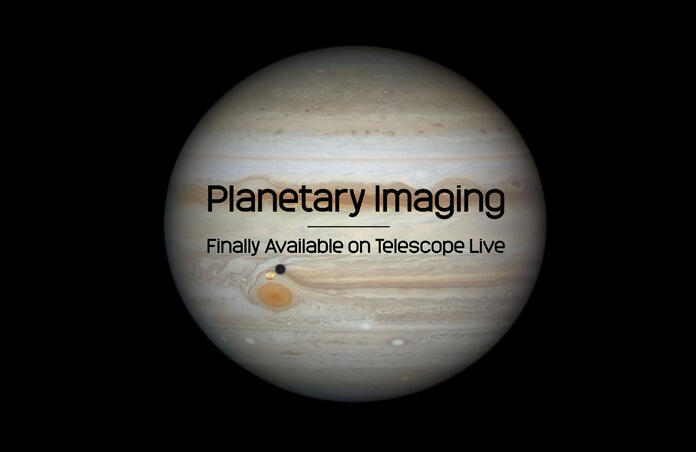Planetary Imaging Finally Available on Telescope Live

Hey everyone!
Today, I'm super excited to announce a look-after addition to the Telescope Live platform: our brand-new Planetary Imaging section.
In this post, I want to guide you through the features of this new section, provide tips for a better user experience, and highlight the tremendous value it adds to your astrophotography journey. Let’s start from the beginning.
A video introduction to this feature
Co-founder Alex Curry shot a quick video introduction that I strongly suggest you to watch before reading the entire post. You can watch his video by clicking here below!
Where to find the section
You can find the Planetary Imaging section conveniently located under the 'One Click Observations' tab on your dashboard.

This isn't simply a collection of planetary images; it is a curated selection of top-tier data, assembled with great care over the last 12-18 months by the esteemed Damian Peach. Damian is not only a master astrophotographer but also a leading expert in planetary imaging, and we're honored to feature his work.
The datasets we're offering go above and beyond our usual archive contents. Each one is the result of extensive hours of imaging and precise calibration, and though this is reflected in a higher price point compared to our standard offerings, the quality and depth of the data warrant this investment.
What kind of data you get
The grabbing mechanism for the Planetary Imaging datasets is akin to our familiar 'One-Click Observations' and 'Observation Bundles'.
When you download one of these datasets, you'll be diving into a collection of stacked TIFF images, ready for processing. These stacks result from an extensive data reduction from the original raw .SER videos, which are often enormous, sometimes exceeding 100GB per video. This pre-stacking condenses what would otherwise be a total in excess of 1TB of data for the entire dataset, into a manageable size without sacrificing the intricate details of the celestial spectacle.
This transition to providing pre-stacked data saves you from the near impossibility of handling massive video files and makes the Planetary Imaging section accessible to all, regardless of your familiarity with planetary imaging.
Understanding Data Types
In your planetary imaging journey, you'll encounter both monochrome and color datasets. The data type depends on the equipment and filters used during acquisition. Our datasets reflect this diversity, and Damian's tutorials will walk you through the distinct processing routines for each.
Why does a planetary dataset cost more than a one-click observation?
Think of these datasets as akin to an Observation Bundle, offering a more complex and nuanced observation experience compared to a simple One-Click Observation.
The price of these datasets reflects not just the quality of the data but also the effort and the seeing conditions, which are critical to successful planetary imaging.
Who can access this section
Only Silver and above subscribers will be able to access this new feature, so if you are a Bronze member and you want to get your hands dirty with some planetary post-processing fun, this might be the right time to upgrade.
Expect a different post-processing experience
Planetary imaging is a completely different beast from deep-sky astrophotography.
We can say that while deep-sky processing is often about maximizing signal and minimizing noise to reveal faint details and colors of distant celestial objects, planetary processing focuses on enhancing and sharpening details, correcting atmospheric effects, and aligning fast-moving targets.
Both types of processing require a great deal of skill and patience to produce stunning images of our universe.
No idea where to start with post-processing? Don’t worry, we've got you covered!
Since we know well how different the processing experience is when practicing planetary imaging, we decided to team up with probably the world’s best in this art: Damian Peach.
Damian is a Telescope Live tutor and, as such, he has started to share his knowledge through comprehensive tutorials, which you can access either through his tutor page or the tutorials section on our website.
Damian has designed a series of tutorials to guide you through this unique processing workflow for each planet (more tutorials will soon be available). Whether you're a beginner or an experienced imager, Damian’s comprehensive tutorials are indispensable for mastering planetary image processing.
Given that processing planetary data is quite different from traditional deep-space astrophotography, these tutorials are not just helpful - they're crucial for anyone wanting to learn the art of planetary image processing.
I strongly encourage you to start with Damian's introduction to planetary imaging and follow up with his processing guide for Jupiter. These resources are key to understanding how to transform raw data into breathtaking images of planetary bodies.
And with that, I will now leave you to this brand new experience finally available to Telescope Live users!
What a week we're having at Telescope Live, right? On Tuesday we announced Telescope Live 4, and today we're launching the new Planetary Imaging Section - and the week is not over yet!
Get ready for some more treats this week. 😉
See You Space Cowboy…
